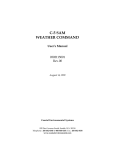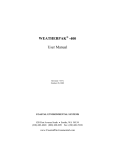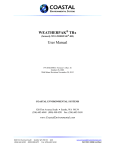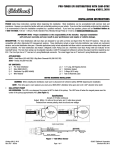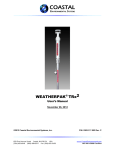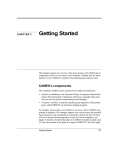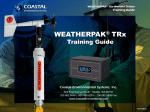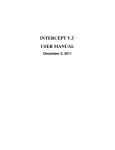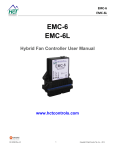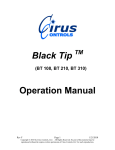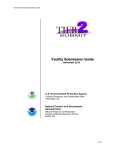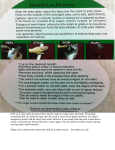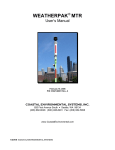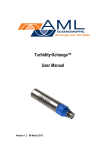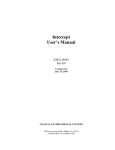Download C-5 SAM-S WEATHER COMMAND - Coastal Environmental Systems
Transcript
C-5 SAM-S WEATHER COMMAND User’s Manual Version 1.0 September 26, 2005 P/N 0302121001 Coastal Environmental Systems 820 First Avenue South, Seattle, WA 98134 Telephone: 206-682-6048 1-800-488-8291 Fax: 206-682-5658 www.coastalenvironmental.com C-5 SAM-S WEATHER COMMAND USER MANUAL SOFTWARE NOTICE ALOHA Plume Dispersion Model ALOHA Version 5.2.1 contains a bug that will not allow interface with automatic data downloads from weather stations (SAM). This bug was fixed in ALOHA Version 5.2.2 and 5.2.3. If you have Version 5.2.1 you can get a FREE download from the E.P.A. website – www.epa.gov/ceppo/cameo 2 COASTAL ENVIRONMENTAL SYSTEMS (206) 682-6048 C-5 SAM-S WEATHER COMMAND USER MANUAL Figure 1 C-5 SAM-S with optional mounting styles shown (tower and vehicle mount) 3 COASTAL ENVIRONMENTAL SYSTEMS (206) 682-6048 C-5 SAM-S WEATHER COMMAND USER MANUAL 1.0 Description The C-5 SAM-S Weather Command is designed with the ruggedness and ease of use that has made the Weatherpak so popular. C-5 SAM-S computes running averages of vector wind speed, vector wind direction, air temperature and stability of the wind. This data, along with the instantaneous measurements of wind speed, direction and air temperature (and optionally Relative Humidity), are updated on the display screen every 30 seconds. C-5 SAM-S can be used as a stand alone station independent of any computer or supporting electronics. It can be used for routine monitoring or in conjunction with the ALOHA plume dispersion model. With or without the dispersion model, the data will allow you to estimate downwind travel time and distance, locate potential impact areas, and target your evacuation zone or identify it in pre-planning practices. List of Components Display/Controller Box. The data is displayed in real time on a Vacuum Fluorescent Display (VFD) with dim/bright switch. The Display/Controller contains the electronics for collection and display of the weather data. It includes an AC power supply to allow you to power the unit from line power. A plug on the Display/Controller allows you to input data directly into your computer for historical record keeping, or to feed data in real time to the ALOHA dispersion model. 1. Sensor Head. This includes the air temperature sensor (relative humidity – optional), the wind monitor with propeller and a data cable to go to the Display/Controller box. 2. Sighting compass. This compass allows you to easily align the sensor head N arrow to TRUE North. Failure to do this will result in incorrect data. 3. Mounting platform (optional). There are portable tower or vehicle mount options. 4 COASTAL ENVIRONMENTAL SYSTEMS (206) 682-6048 C-5 SAM-S WEATHER COMMAND USER MANUAL 2.0 Setup 2.1 Align the sensor head toward TRUE NORTH. Unless you live in Madison, Wisconsin or Birmingham, Alabama, when you hold up a compass it does not point to TRUE NORTH. A compass points to MAGNETIC NORTH and you want the C-5 SAM-S aligned to TRUE NORTH because that is how all maps are oriented. The easiest way to align the sensor head with north is to use the sighting compass provided with the C-5 SAM-S. 1. Determine the magnetic variation of the city where the C-5 SAM-S will be used (your local airport or weather bureau can help). A list of some major cities is provide in this manual. Once you have determined the magnetic variation for your particular city, (say 20° E for Seattle or 5° W for Charleston) then you must take this into account when sighting the compass. 2. Hold the sighting compass at eye level with your arm fully extended. Be sure the sights in front and in back of the compass are lined up with your line of vision. Turn your body or move your arm until you also have the compass N in line with the sights. 3. Now compensate for the magnetic variation of your city. For an EAST variation SUBTRACT; for a WEST variation ADD the degrees to 360° (NORTH). If you are in Seattle you must subtract 20°. (Remember that on a compass 360 and 0 are both at North). So move your arm until you can see approximately where 340° would be on the compass. NOW your sight is aimed at TRUE NORTH. 4. While holding your aim at TRUE NORTH, select some nonmoving object in the distance (a tree, a pole, a crack in a building) as your north reference. The north reference should be at least 100 feet away but, the farther away, the better. 5 COASTAL ENVIRONMENTAL SYSTEMS (206) 682-6048 C-5 SAM-S WEATHER COMMAND USER MANUAL Figure 2 Hand held sighting compass 5. Slip the sensor head on to whatever you are mounting it to, (portable tower, vehicle mount, or a permanently mounted pole). Use the north indicator tab (white plastic arrow head) to aim the sensor head to your chosen north reference. After north alignment, tighten down the locking knob on the neck of the sensor head. 6. If you raise the sensor head now – BE SURE TO KEEP THE ARROW HEAD ALIGNED WITH YOUR NORTH REFERENCE. If for some reason you move the C-5 SAM-S during its use, you must keep it aimed constantly North. (Remember, if you move C-5 SAM-S your reference point may no longer be due north of the new location.) If it is not possible to keep the North alignment while moving the C-5 SAM-S, you must turn the C-5 SAM-S off and restart it when it is in the new position and again aimed TRUE NORTH. 6 COASTAL ENVIRONMENTAL SYSTEMS (206) 682-6048 C-5 SAM-S WEATHER COMMAND USER MANUAL 2.2. Connect all cables. 1. The Display/Controller box should be wall mounted or attached firmly to a base. 2. Route the data cable from the sensor head to the Display/Controller box. Attach the data cable to the Display/ Controller box via the 12 pin connector/terminal strip on side of the box. 3. Plug in the power supply then plug the power supply into a 110 outlet. 4. A cable can be run from the RJ connector on the Display/Controller to a Serial Comm port of a computer. 2.3 Turn on power. Turn on the power switch on the front of the Display/Controller box. The power light next to the switch comes on to indicate the C-5 SAM-S is on. If you wish to connect the Display/Controller directly to your vehicle or other power, eliminate the power supply and wire in 9 – 12 volts DC (minimum 1 Amp) directly to the controller. On the power plug, the tip is (+) and the ring is (-). 3.0 Operation Forty five seconds after the C-5 SAM-S unit is turned on it begins sampling it’s weather sensors at a continuous rate of once per second. The C-5 SAM-S processes both immediate and average weather data. The data averages are a running five minute average, calculated every 30 seconds. At 30 second intervals the display will be updated to show the current weather conditions. The first display update occurs about one minute after turning the unit on. The data light on the front panel of the Display/Controller box will turn on briefly when the data on the display is updated. If the C-5 SAM-S unit has been out of operation for five minutes, a value of –1 (minus one) in the wind stability field indicates the average data has not been calculated over a full five minute period. (You need a full 5 minutes to calculate a valid number for stability). 7 COASTAL ENVIRONMENTAL SYSTEMS (206) 682-6048 C-5 SAM-S WEATHER COMMAND USER MANUAL The data on the screen appears as follows: Figure 3 Close up of data on display – international versions will display metric units Wind Speed (WS) 5 minute running average (see details below) in mph or m/s Wind Direction 5 minute running average of direction wind is coming “from” in degrees or ordinal points (N, W, SW, etc.) See the table that translates ordinal points to degrees Instantaneous Wind Speed (IW) Exact wind speed during last one second before updating display (See details below) Stability (STAB) Value describing how much wind “mixing” is occurring within the wind direction. (See details below) Temperature (TEMP) 5 minute running average of air temperature in °F Or °C Relative Humidity (RH) 5 minute running average in percentage. Identification (ID) Your C-5 SAM-S unit identification )assigned at the Factory) Barometric Pressure (BP) Average barometric pressure in In Hg (inches of Mercury) 8 COASTAL ENVIRONMENTAL SYSTEMS (206) 682-6048 C-5 SAM-S WEATHER COMMAND USER MANUAL STABILITY Stability of the wind is the biggest determinant of how far plume will travel downwind. Stability is measured by electronically checking where the vane is located every second. Since the vane in normal wind is always moving—the stability will never be zero (unless you held the vane in place perfectly for 5 minutes). Stability is the standard deviation of the wind direction and can range from 0 to about 120. As was discussed you will never see zero nor will you ever see 120, however, a wind with a stability above 25 is a fairly unstable wind. This is good if you have a spill because it means the plume will disperse more rapidly (it will however be broader). Bad news is a stability of 10 or less. This means the air is not mixing much and the plume will travel much further. For more precise downwind distances it is necessary to use a plume dispersion model which considers the exact chemical type, all the weather conditions, how much was spilled, etc. 5 MINUTE RUNNING AVERAGE A 5 minute running average of the wind will always be lower than what you think the wind speed will be. This is because the wind usually comes in gusts and eddies, creating high speeds interspersed with low speed areas. It is not uncommon for people to guess the wind speed at about twice as high as the 5 minute average. INSTANTANEOUS WIND SPEED This is the exact speed of the wind in the one second before the Display/Controller updates the display. IT IS NOT A GUST SPEED, unless the gust is occurring at the exact second the reading is taken. It is possible to have an instantaneous speed of 0 to 1 in an 8 MPH average wind—it just happened to occur during that one second. The above calculations have been determined by the US EPA, NOAA and other agencies to be the best representation of the meteorological conditions that will most accurately reflect traveling distances and locations of hazardous vapors etc. and still present the data in a timely manner. 9 COASTAL ENVIRONMENTAL SYSTEMS (206) 682-6048 C-5 SAM-S WEATHER COMMAND USER MANUAL MISSING DATA If the sensor head is not connected, all the fields on the display show an “M” as missing data except ID and BP. If you are connected to a PC – AND if the sensor head is not connected, all data fields on the screen will show “M” except ID, BP, power and checksum. Chart showing Ordinal compass points and degrees (equivalent) ORDINAL COMPASS POINT N NE E SE S SW W NW DEGREES 0° OR 360° 45° 90° 135° 180° 225° 270° 315° 10 COASTAL ENVIRONMENTAL SYSTEMS (206) 682-6048 C-5 SAM-S WEATHER COMMAND USER MANUAL Table of Magnetic Variances in some major Cities CITY BALTIMORE BOSTON CHICAGO CHARLESTON DALLAS DENVER DETROIT HOUSTON KANSAS CITY LOS ANGELES MIAMI NEW ORLEANS NEW YORK PHOENIX PORTLAND, OR SALT LAKE CITY SAN FRANCISCO SEATTLE ST. LOUIS WASHINGTON D.C. LISBON LONDON MADRID PARIS ROME STOCKHOLM VIENNA ZURICH MAGNETIC VARIATION 10°W 16°W 1°W 15°W 6.5°E 11.5° 5.5°W 6°E 5°W 14°E 3°W 3°E 12.5°W 12.5°E 19.5°E 15°E 16°E 20°E 2°E 9.5°W 5°W 3°W 3°W 1°W 1°E 3°E 2°E 0° NOTE: The above chart is for 1986 and the variation shifts slightly each year. Consult your local airport, weather service, or a marine supply dealer for the current year magnetic variation for your location. 11 COASTAL ENVIRONMENTAL SYSTEMS (206) 682-6048











